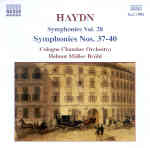These generally fine performances focus on four interesting Haydn symphonies–but then, aren’t they all? The best known is No. 39 in G minor, which inspired Mozart’s No. 25 in the same key. With its four horns and Sturm und Drang anxiety it’s a powerful and impressive work, and Helmut Müller-Brühl captures its nervous tension well in both outer movements. No. 40 in F is unusual for its concluding fugue, rendered here with exemplary clarity, while both Nos. 37 and 38 feature trumpets, timpani, and (in the latter) those thrilling high-C horns that were such a Haydn specialty. In all three works the playing of the Cologne Chamber Orchestra is immaculately clean and lively, very gracious in the slow movements, and dashingly rhythmic in the minuets.
I do have one rather large reservation, however, and this concerns the presence of the harpsichord continuo. As is now well known, there is no evidence that Haydn ever required one, and whether it’s in or out has become something of an issue among scholars. I land squarely on the side of those who prefer not to hear a harpsichord, for several reasons: (1) it forces the other players to adapt to its limited dynamic range, reducing Haydn’s scheme of contrasts; (2) it creates artificial rhythms out of Haydn’s bass lines and gives the music a mechanical character; (3) it imposes a timbral homogeneity on the music that’s at odds with Haydn’s colorful and discriminating use of wind instruments; (4) worst of all, it’s almost invariably recorded too loudly, and when the player can’t resist the occasional flourish the result is uncharacteristically coy. When, as here, the harpsichord is sometimes more prominent than trumpets and drums (and these performances are well recorded on the whole), then that isn’t the Haydn I know and love.
Others may feel differently, and I raise the issue so that listeners can make their own informed choices. I do recognize and enjoy the high level of artistry at work on this disc, and I don’t want to demean the efforts of Müller-Brühl and his fine band or make this out to be a bigger problem than it is. Lots of conductors opt for the continuo, the vast majority in fact, and the simple truth is that none of the recordings that leave it out in Symphonies Nos. 37 and 38 (certainly not Hogwood, for example) are overwhelmingly more convincing than these. In Nos. 39 and 40 however, Thomas Fey on Hänssler offers a far more judicious and musically apt approach to the use of the harpsichord, but his couplings are different (Symphonies Nos. 34 and 50). It’s your call!
































